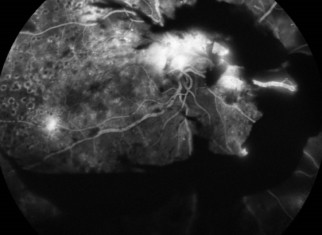
Vitreous hemorrhages may be of different degrees. Severe bleedings may cause a sudden and complete loss of vision, while mild ones cause blurred vision or the appearance of floaters. Eye injuries, surgical interventions and vascular disorders are its most common causes.
| Symptoms of a vitreous hemorrhage |
|---|
| Small translucent spots or shadows Blurred vision Sudden loss of vision It may be due to many causes, from injuries, to surgeries, vascular disorders, inflammations (uveitis) or eye tumors |
A vitreous hemorrhage is the presence of blood within the eye cavity that is filled with vitreous humor. The vitreous humor is a jelly-like, clear substance made up mostly of water that fills up to two thirds of the eyeball total volume. In the front part of the vitreous humor, we find the crystalline lens and in the rear side, the retina.
When there’s blood within the vitreous humor, this substance loses its transparency, reason why light cannot go through it and the patient experiences vision loss.

Vitreous hemorrhages may be due to:
The main symptom in a patient suffering a vitreous hemorrhage is a sudden loss of vision, but it all depends on the severity of hemorrhage.
In all cases when a patient experience the above-mentioned symptoms, a comprehensive eye examination will be needed. This will comprise visual acuity, eye fundus examination and, in the case of severe bleedings, an eye ultrasound will be performed in order to rule out the retinal detachment. In these cases, it is also important to monitor intraocular pressure, as blood from hemorrhage may obstruct an eye structure known as trabecular meshwork, which may hinder the drainage of aqueous humor and even lead to glaucoma.
The treatment for vitreous hemorrhage depends on the hemorrhage cause and degree of severity.
A wait-and-see approach is usually adopted, as mildest bleedings are usually spontaneously reabsorbed in a 2 or 3-month period.
In case of patients presenting complications, such as a retinal detachment, or in the event of unabsorbed bleedings, a retinal surgery known as vitrectomy must be performed in order to eliminate such bleedings.
It is important as well to always assess whether there is an underlying cause, such as a diabetic retinopathy or vein thrombosis, as in the case of such patients, it may be necessary to apply an Argon laser treatment on the retina.

Contact us or request an appointment with our medical team.